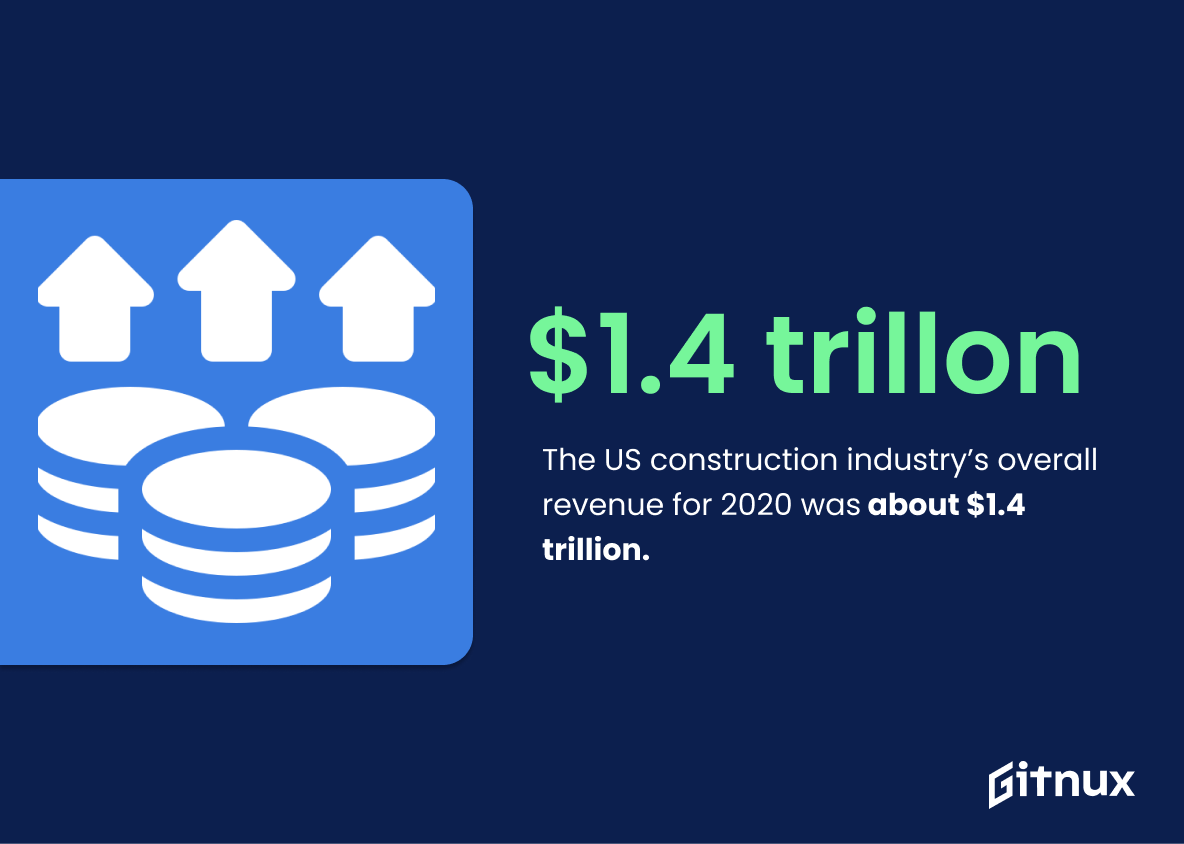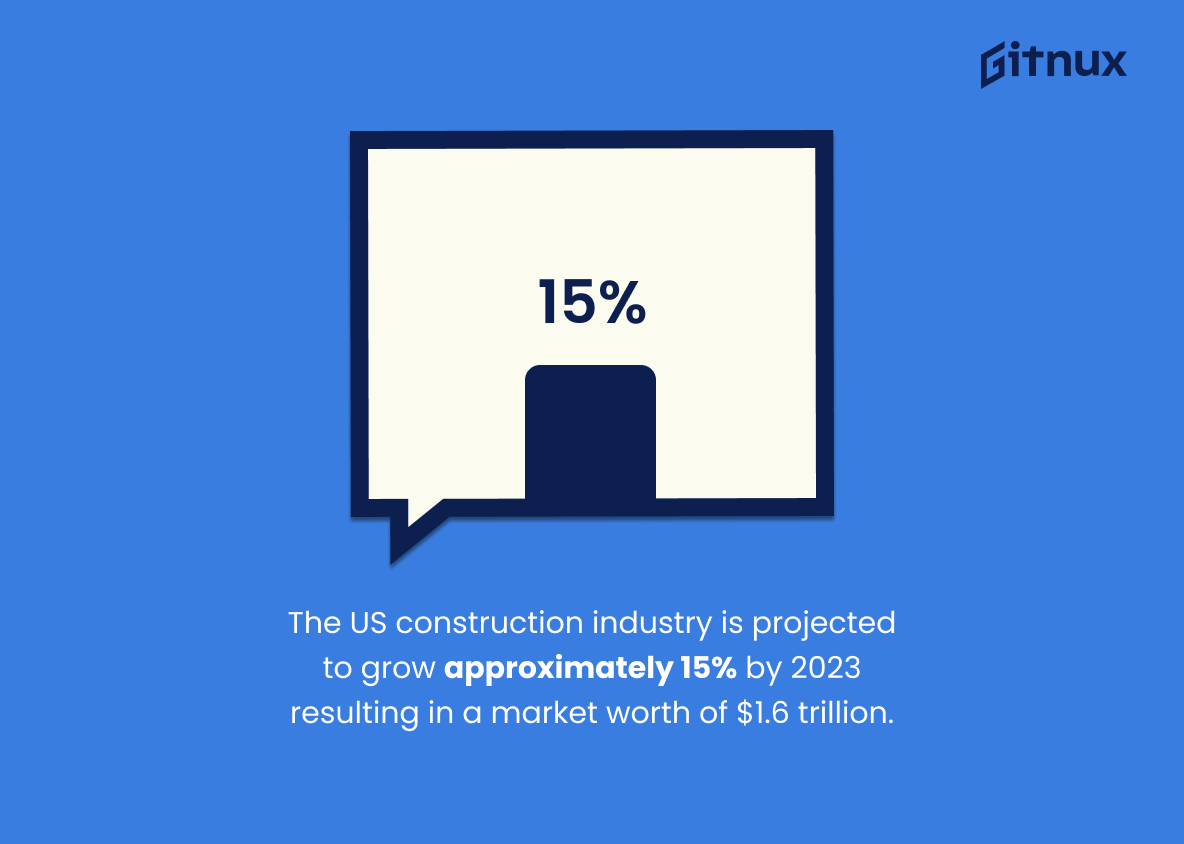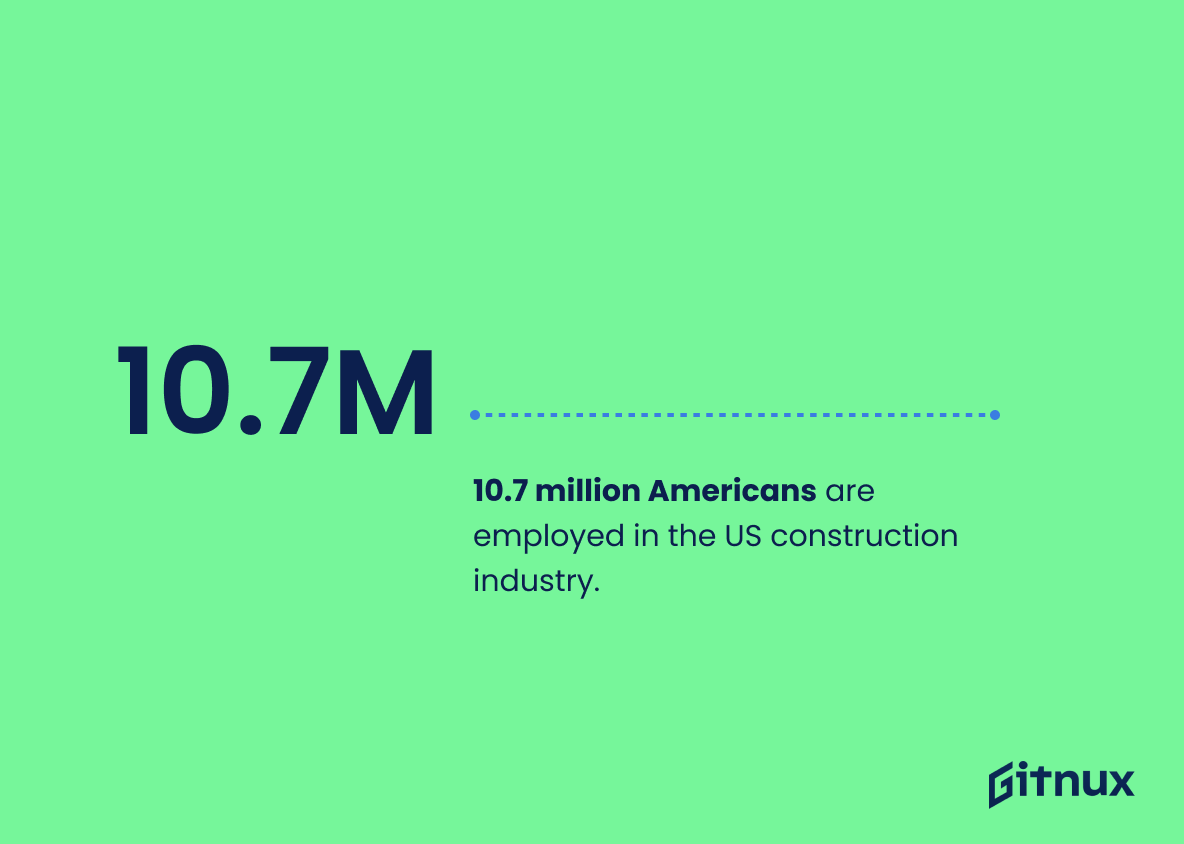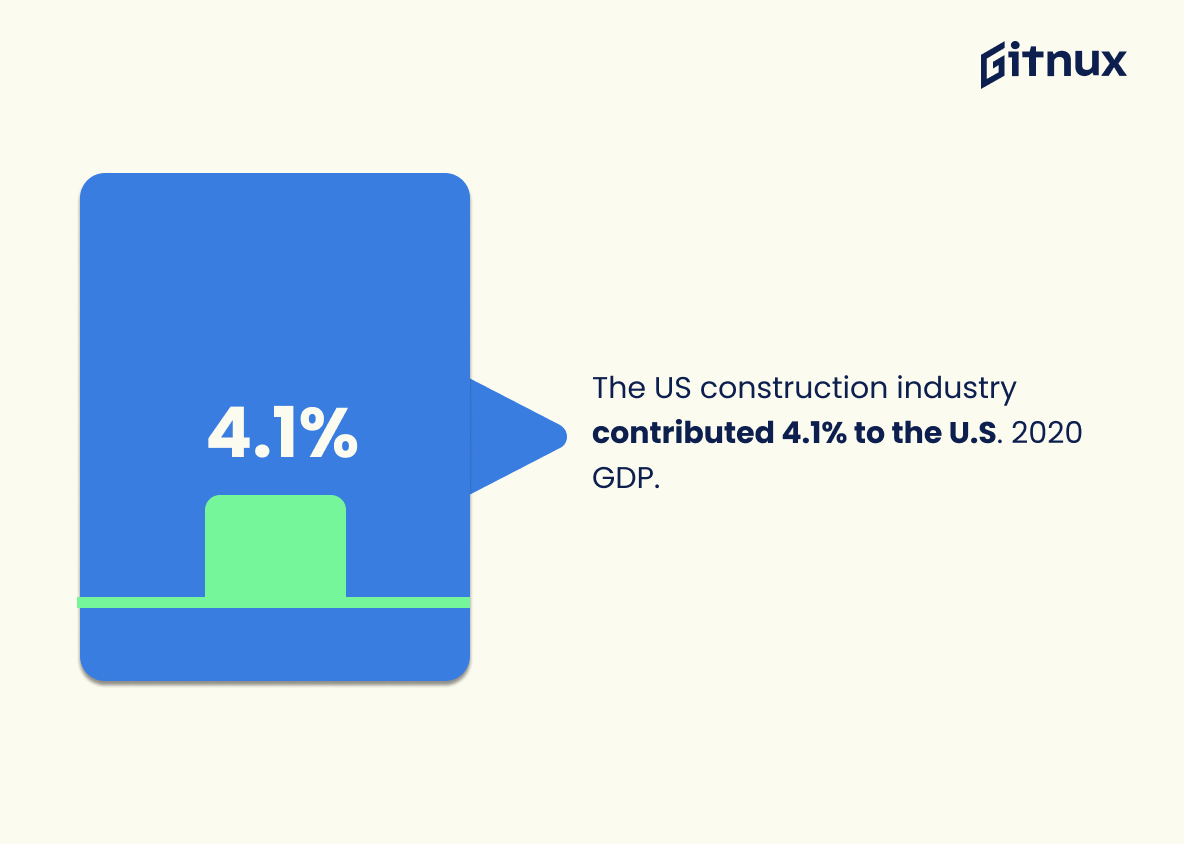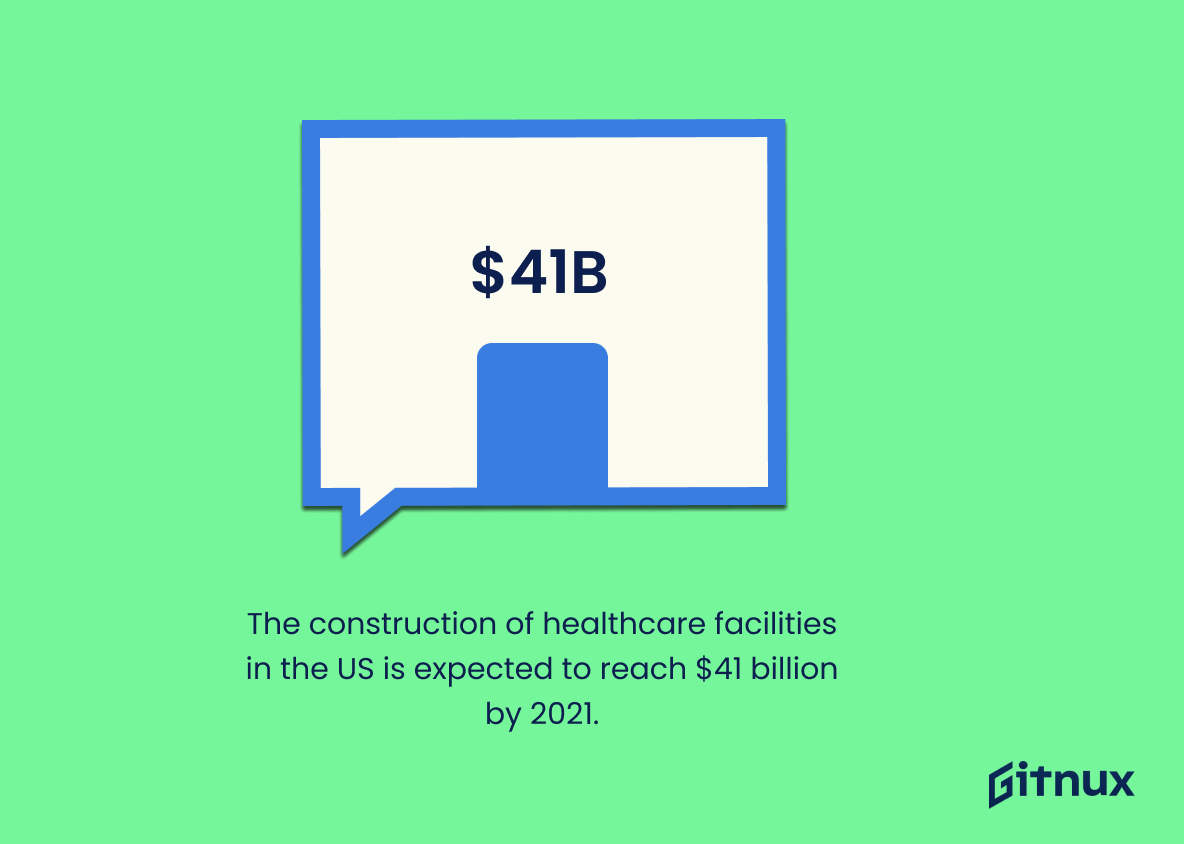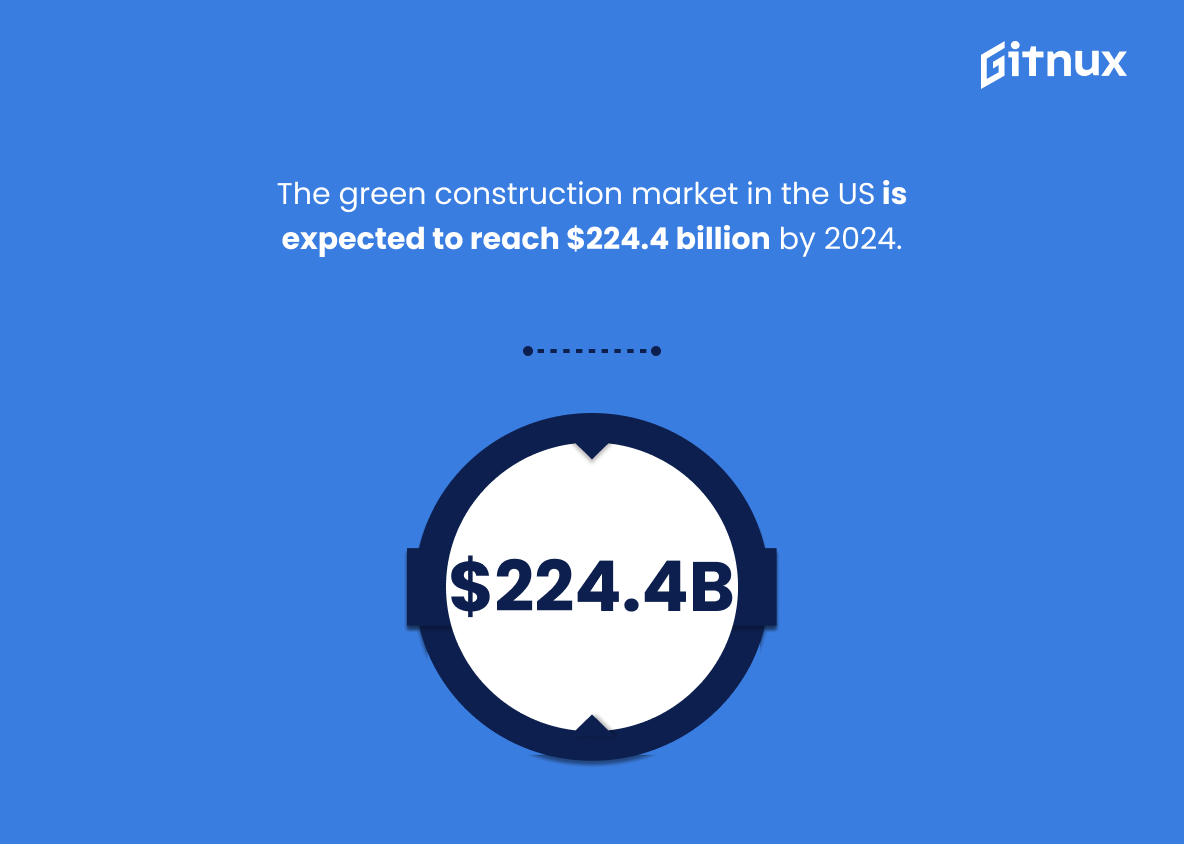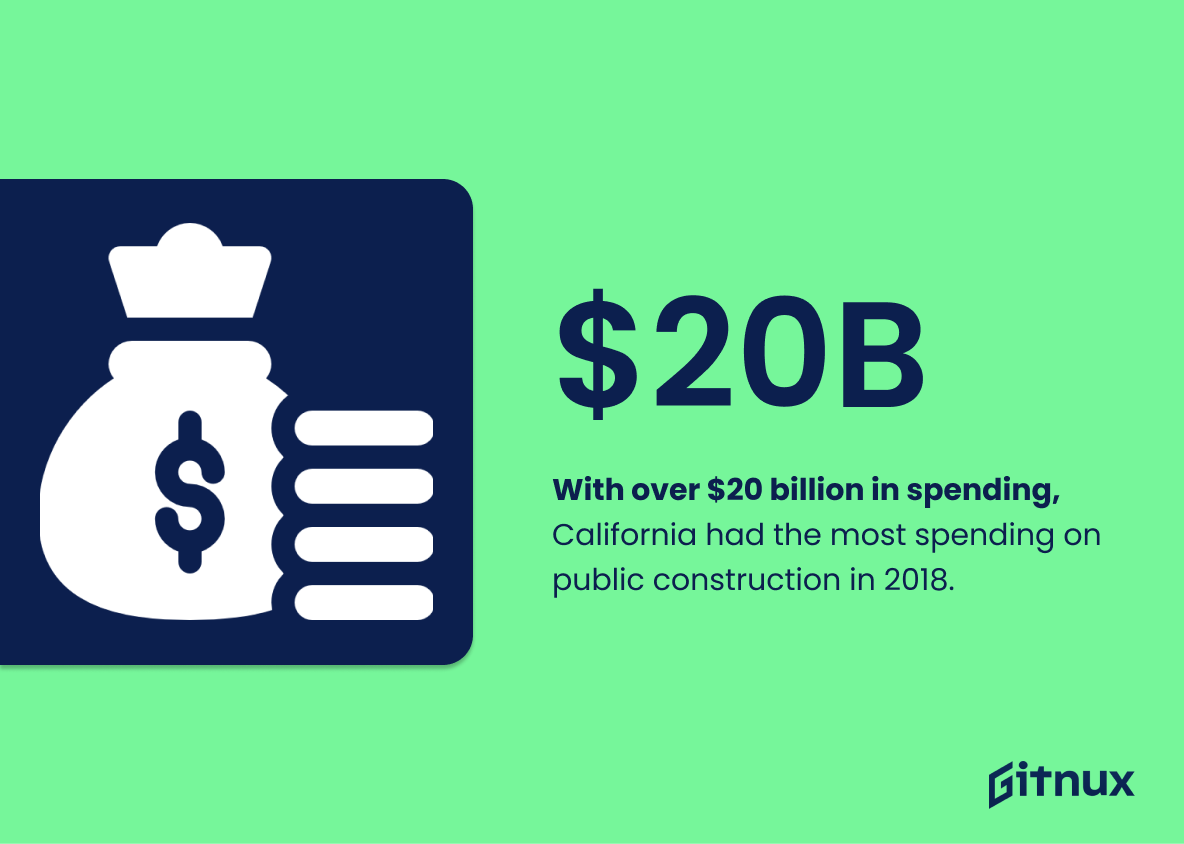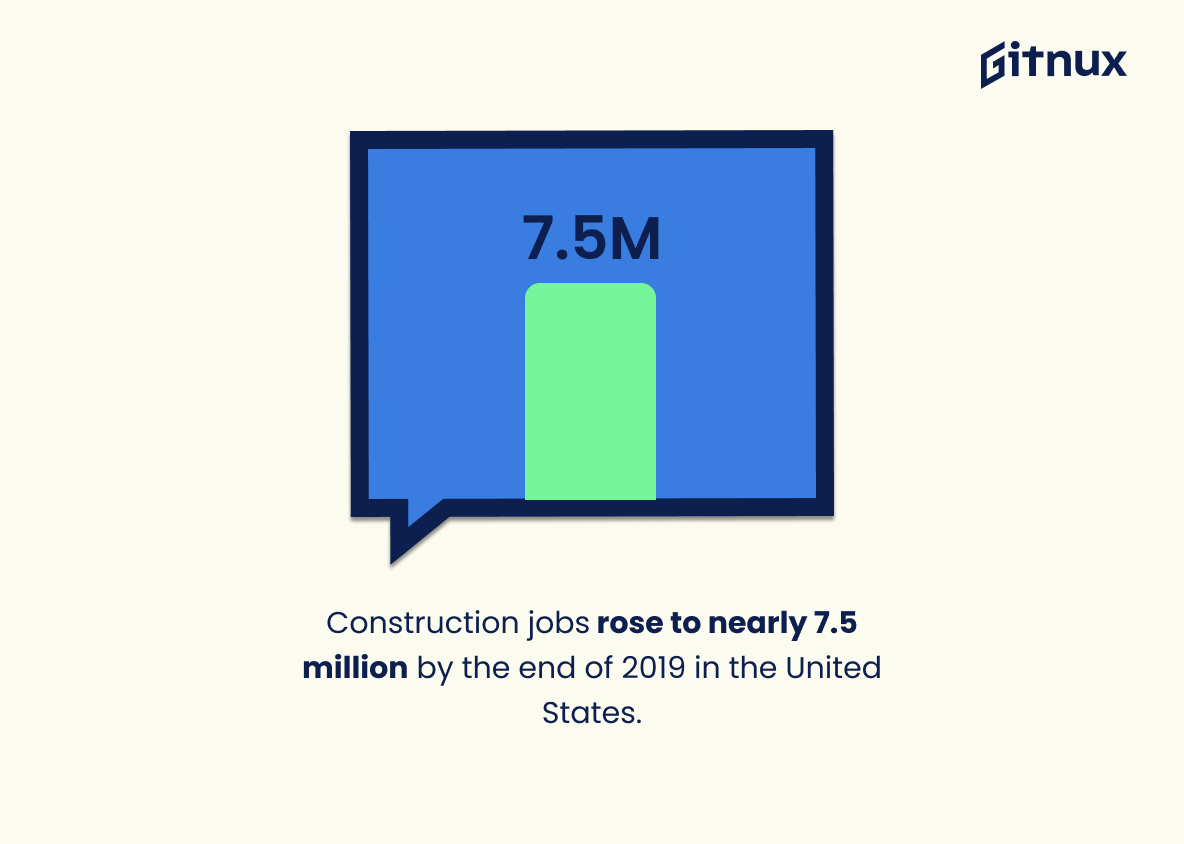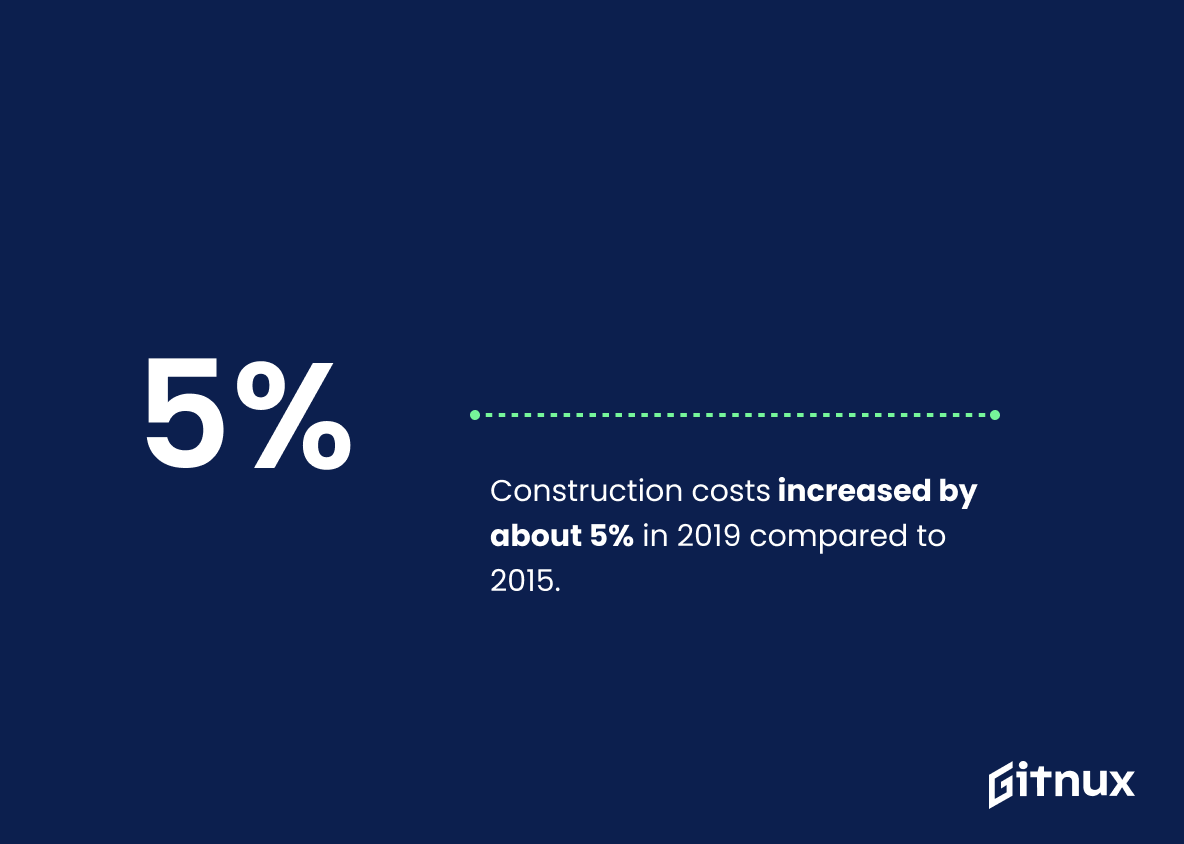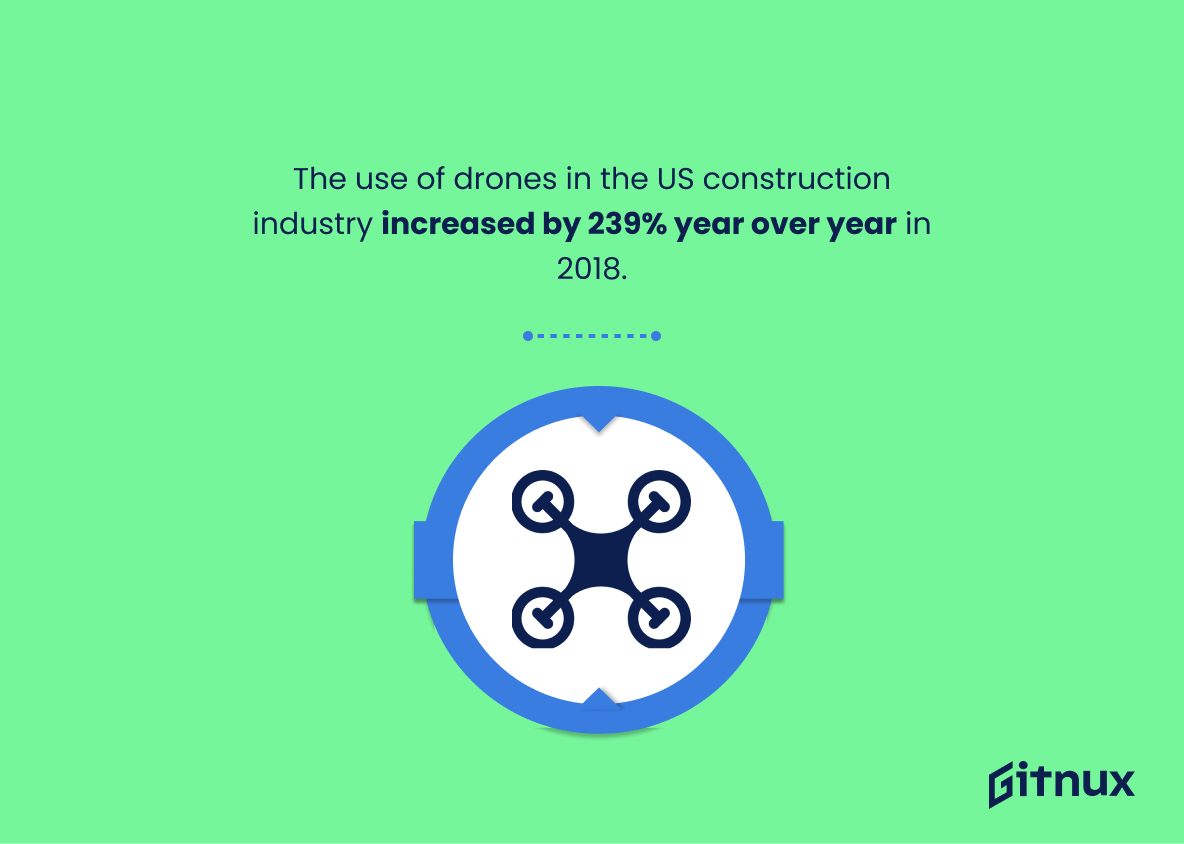Welcome to our deep dive into the dynamic world of the US construction industry. This powerhouse sector is built on numbers, metrics, and statistics, and understanding these could mean the difference between triumph and defeat for business strategists, investors, or those simply intrigued by the nuances of the industry. With this blog post, we aim to demystify key statistics that govern this vast industry. Whether you are a seasoned industry player seeking updates or a newcomer eager to learn, we’ll guide you through the most relevant and recent US construction industry statistics, giving you a comprehensive understanding of the market trends, growth indicators, economic impact, and the potential trajectory of this influential and ever-evolving industry.
The Latest Us Construction Industry Statistics Unveiled
The US construction industry’s overall revenue for 2020 was about $1.4 trillion.
Reflecting on the mentioned statistic, one can marvel at the sheer significance the US construction industry holds. A remarkable revenue of $1.4 trillion in 2020 underscores its prominence in fueling the nation’s economy. This striking figure offers an insight into the industry’s immense contribution to the US GDP, displaying not only its economic impact but also the level of employment and development opportunities it provides. For anyone evaluating the industry in-depth, this number forms a comprehensive backdrop, offering quantitative evidence of the industry’s strength and resilience in the face of a challenging year marked by the global pandemic. Delving into these statistics encourages a deep dive into understanding industry trends, performance, forecast, and its interrelation with other sectors, a must-read element in a blog post about US Construction Industry Statistics.
The US construction industry is projected to grow approximately 15% by 2023 resulting in a market worth of $1.6 trillion.
Delving into the exciting anticipation of the U.S. construction industry’s growth, this dynamic projection of a 15% rise by 2023 establishes a bold promise for the sector’s bullish transformation. With a market worth soon to hit the $1.6 trillion mark, the industry’s tectonic shifts underpin the limitless potential for investors, suppliers, and workers alike. This projected leap not just shines light on the increasing demand for construction services, but also tells a tale of economic prosperity, job creation, and increased consumer spending. Therefore, it is not just a number, but a power-packed forecast stamping its impact on every blog post about U.S. Construction Industry Statistics. The ripple effects of this prediction are far-reaching, impacting every sector linked to this foundational industry.
10.7 million Americans are employed in the US construction industry.
Painting a vibrant image of the lifeblood of the US construction industry, 10.7 million Americans are its dynamic workforce. Their numbers offer a snapshot into the sector’s astounding magnitude as they collectively develop the physical backbone of the nation. From sky-scraping office towers to cozy neighborhood homes, each construction project is a testament to these millions’ labor. Therefore, when synthesizing construction industry statistics in the US, acknowledging the workforce size not only underscores the industry’s significance in supporting millions of livelihoods but also punctuates its potential impact on our economy, making it a central supporting pillar in our exploration of US construction industry statistics.
The US construction industry contributed 4.1% to the U.S. 2020 GDP.
Peeking behind the curtain, it’s worth noting that the US construction industry fueled 4.1% of the American GDP in 2020. This piece of data is significant – it depicts the industry as one of the key drivers of financial growth within the panorama of the country’s economy. The magnitude of its contribution reiterates the sector’s significance – not only in terms of infrastructure development but also as a bellwether for the economic health. This interplay between construction industry and GDP subtly outlines how this robust industry, often seen in terms of bricks and mortar, is actually an artery pulsating wealth into the economic body of the nation.
The US construction industry saw a 3% decrease in value, between 2019 and 2020.
Interpreting the numbers, we sail through the sea of data and stumble upon a significant observation. The US construction industry witnessed a subtle yet impactful decrease of 3% in value between 2019 and 2020. This pivotal detail, represented as a mere percentage, paints a broader landscape of economic health, industry dynamics, and their impact on overall market trends.
Bearing witness to the ripples created by this 3% change, the construction industry underwent a perceptible shift in its trajectory. This value, though seemingly small, signifies changes in industry performance, profit margins and costs, affects projections for future growth, and influences business decisions of stakeholders across the spectrum. It subtly reveals the pulse of the industry, offering vital insights to investors, contractors, suppliers, and policymakers alike.
From a more macroscopic vantage point, this 3% decrease becomes a subtle indicator of the nation’s overall economic performance and possibly a reflection of societal responses to global events, such as a pandemic or a natural disaster. So, as we dive deeper into the analysis of the US Construction Industry, remember – even a percent matters, as it’s not just a number, it’s a story in disguise.
In 2020, New York saw the highest amount of construction spending in the U.S. at $55.5 billion.
Highlighting the massive $55.5 billion construction spending in New York in 2020 certainly throws a spotlight on the pulse of the U.S. construction industry. It showcases the scale and vitality of construction activities in the nation’s most populous city, indicating a thriving demand for new projects, despite a challenging year. The figure lends credibility to New York’s significant influence on the industry’s economic landscape, shaping trends and influencing its future direction. Furthermore, it sets a precedent for other states to gauge their construction activity and underlines the potential for industry growth nationwide. Additionally, it reflects the substantial role the sector plays in fueling job creation, urban development, and overall economic progress in the U.S.
The construction of healthcare facilities in the US is expected to reach $41 billion by 2021.
This forecasting gem, predicting the construction of healthcare facilities in the US to reach a plush $41 billion by 2021, paints a vibrant illustration of the potential boom in the construction industry. Imagine an infusion of such magnitude, not only bolstering the construction market but creating job opportunities and enhancing the overall economy. This is not just a statistic; it’s an economic prophecy for construction magnates and stakeholders. Weaving this into a broader tale of the US Construction Industry Statistics, it emphasizes the vitality of the healthcare sector as a vibrant cornerstone, highlighting the industry’s potential and giving investors, economists, and contractors an intriguing storyline worth tracking.
In 2019, around 885,000 single-family homes were constructed in the USA.
Painting a picture of the robustness of the US construction industry, the construction of approximately 885,000 single-family homes in 2019 shines a spotlight on the industry’s vitality and growth potential. This dramatic figure underscores the active role the sector plays in satiating America’s housing needs. It also provides invaluable insight into the health of the economy, employment rates in associated industries, and the accessibility of housing finance. Thus, it becomes a cornerstone of any detailed analysis or discussion revolving around US Construction Industry Statistics.
Over 31,000 publicly funded construction projects are currently underway in the US.
Unraveling the sphere of the ongoing 31,000 publicly funded construction projects in the US sheds light on the significant investment in infrastructure development and improvement being made by public entities. It serves as an eye-opener to the scale of physical growth and innovation currently shaping the American landscape. With such a high number of ongoing projects, one can fathom the massive workforce employed in and the economic power generated by the construction industry. Furthermore, this figure underlines the potential opportunities for businesses tied to the construction industry, be it construction firms, labor, material suppliers, or related sectors like realty and engineering. This statistic is thus a riveting testament to the vitality of the US construction industry.
The green construction market in the US is expected to reach $224.4 billion by 2024.
An unveiling of such an astounding crescendo in the green construction market, expected to touch $224.4 billion by 2024, adds a twist of ecology-conscious development to the US construction industry narrative. Like the exceptional rise of a soaring eagle, this anticipated growth signifies not just an industry on the move, but a whole nation pivoting towards more environmentally friendly practices in construction. This accentuates the appeal and significance of holistic, sustainable design and building management approaches that help to conserve resources while also reducing harmful emissions. This imminent green transition is poised to shape the US construction industry modernization, setting tantalizing and potentially transformational trends for investors, stakeholders, and industry players to watch.
With over $20 billion in spending, California had the most spending on public construction in 2018.
Highlighting the sheer scale of California’s public construction spending of over $20 billion in 2018 underlines the pivotal role the state plays in the wider tapestry of the US construction industry. The statistic, in essence, serves as a testament to California’s dynamic construction landscape, but it also throws into sharp relief the fiscal momentum the state contributes to the national construction scene. By underscoring the immensity of this spending, we lift the lid on just how influential single state investment can be, painting a larger picture of the robustness and resilience of the US construction industry as a whole. Therefore, California isn’t just investing in its own infrastructural future, it’s critically aiding in scaffolding the progress of US construction industry as a whole – a fact reflected in its impressive spending figures for 2018.
Construction jobs rose to nearly 7.5 million by the end of 2019 in the United States.
Highlighting that construction jobs rose to nearly 7.5 million by the end of 2019 in the United States beautifully underscores the vitality of the US construction industry. It serves as a sturdy cornerstone representing growth and stability, effectively resonating with the increasing potential of this vast sector. In the larger portrait of industry statistics, this phenomenon sheds light on a prosperous trend which could inspire investors, governments, and key stakeholders to further cultivate, support, and bolster this critical industry.
Construction costs increased by about 5% in 2019 compared to 2015.
Highlighting the 5% increase in construction costs from 2015 to 2019 serves as a key indicator of the escalating financial demands in the US construction industry. It spotlight’s the industry’s economic climate, hinting at potential challenges that constructors faced during this period, as they grappled with rising expenditure. Furthermore, it underscores vital trends for investors, policymakers, and industry stakeholders to consider, linking directly into the broader market dynamics. It’s a reflection of a myriad of influences like inflation, labor costs, and material cost changes. Ultimately, this particular detail paints a panoramic view of the financial evolution and unpredictability within the construction industry.
The U.S. residential construction market was worth $507.2 billion in 2020.
A glimpse into the vitality of the U.S construction industry can be discerned by examining the staggering $507.2 billion valuation of the residential construction market in 2020. This affirms not only the significant role of this sector in driving economic growth but also underscores the potential for investment opportunities. In the vast-spectrum of the overall construction industry, the substantial value of the residential market offers keen insights on consumer housing trends, financing rates, and regulatory implications. Perfectly illustrating the dynamism of the industry, this figure essentially shines a spotlight onto the foundational bricks that build the American economy, providing valuable perspective for everything from investment strategies to public policy decisions.
The use of drones in the US construction industry increased by 239% year over year in 2018.
Unveiling a significant leap of 239% in drone usage within the U.S construction industry in 2018 underlines an evolving trend. This powerful percentage shift throws open a fascinating narrative on digitization and automation for our readers. It illustrates the rapid transformation of traditional work protocols, painting a picture of an industry embracing technological progress to enhance efficiency and precision in operations.
Examining such a tremendous upswing also demonstrates the industry’s ceaseless search for innovative solutions to improve dangerous and labor-intensive tasks. Readers gain insight into how the use of unmanned aerial vehicles (UAVs) or drones in construction has become an elemental factor in data collection, safety inspection, surveillance, and even 3D modeling. Capturing this dizzyingly steep ascent helps underscore the significance of drones as a disruptive technology shaping the construction landscape of tomorrow.
The U.S. construction industries use around 60% of all tower cranes in operation worldwide.
This number, depicting U.S. construction industries using approximately 60% of all tower cranes in operation worldwide, serves as a robust indicator of the vast scale and intensity of construction activities in the U.S. Picture that, with this statistic at our fingertips, we can color a vivid image of the American skyline being continuously reshaped and reimagined. Think about how this may suggest that America isn’t just a land of opportunities for people, but also a playground for architectural innovation and development. It’s a testament to the sheer size of the U.S construction industry, its role in driving economic growth, and a telltale sign of an unquenchable hunger for urbanization and technological advancements in the sector.
Conclusion
The numbers make it clear: the US construction industry is not just surviving, but thriving, making a monumental contribution to the country’s economy. With steady growth, a promising job market, and a progressive surge in green construction, this sector is undeniably a cornerstone in America’s economic prowess. However, it’s important to keep an eye on the challenges that lie ahead, such as labor shortages and supply chain disruptions. Regardless, armed with these statistics, businesses, investors, and job seekers can align their strategies to capitalize on the emerging trends and opportunities in this dynamic and resilient industry. As we move forward, the role of technology and sustainable practices in shaping the future of the US construction industry cannot be overstated, making it an exciting space to watch.
References
0. – https://www.www.bea.gov
1. – https://www.www.citylab.com
2. – https://www.www.ibisworld.com
3. – https://www.www.bdcnetwork.com
4. – https://www.www.engineeringspecifier.com
5. – https://www.www.statista.com
6. – https://www.www.buildcentral.com
7. – https://www.constructible.trimble.com
8. – https://www.www.agc.org
9. – https://www.www.wingtra.com
